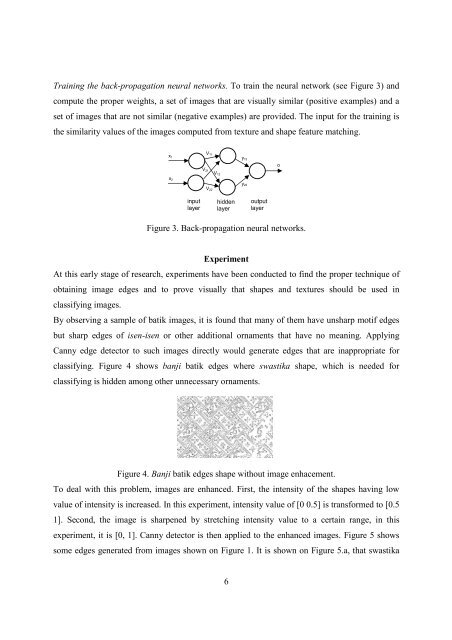TOWARDS CLASSIFYING CLASSICAL BATIK IMAGES - Unpar
TOWARDS CLASSIFYING CLASSICAL BATIK IMAGES - Unpar
TOWARDS CLASSIFYING CLASSICAL BATIK IMAGES - Unpar
Create successful ePaper yourself
Turn your PDF publications into a flip-book with our unique Google optimized e-Paper software.
Training the back-propagation neural networks. To train the neural network (see Figure 3) and<br />
compute the proper weights, a set of images that are visually similar (positive examples) and a<br />
set of images that are not similar (negative examples) are provided. The input for the training is<br />
the similarity values of the images computed from texture and shape feature matching.<br />
x1<br />
x2<br />
input<br />
layer<br />
V21<br />
V11<br />
V22<br />
V12<br />
hidden<br />
layer<br />
Figure 3. Back-propagation neural networks.<br />
Experiment<br />
At this early stage of research, experiments have been conducted to find the proper technique of<br />
obtaining image edges and to prove visually that shapes and textures should be used in<br />
classifying images.<br />
By observing a sample of batik images, it is found that many of them have unsharp motif edges<br />
but sharp edges of isen-isen or other additional ornaments that have no meaning. Applying<br />
Canny edge detector to such images directly would generate edges that are inappropriate for<br />
classifying. Figure 4 shows banji batik edges where swastika shape, which is needed for<br />
classifying is hidden among other unnecessary ornaments.<br />
Figure 4. Banji batik edges shape without image enhacement.<br />
To deal with this problem, images are enhanced. First, the intensity of the shapes having low<br />
value of intensity is increased. In this experiment, intensity value of [0 0.5] is transformed to [0.5<br />
1]. Second, the image is sharpened by stretching intensity value to a certain range, in this<br />
experiment, it is [0, 1]. Canny detector is then applied to the enhanced images. Figure 5 shows<br />
some edges generated from images shown on Figure 1. It is shown on Figure 5.a, that swastika<br />
6<br />
y12<br />
y22<br />
output<br />
layer<br />
o




